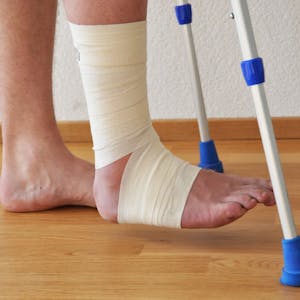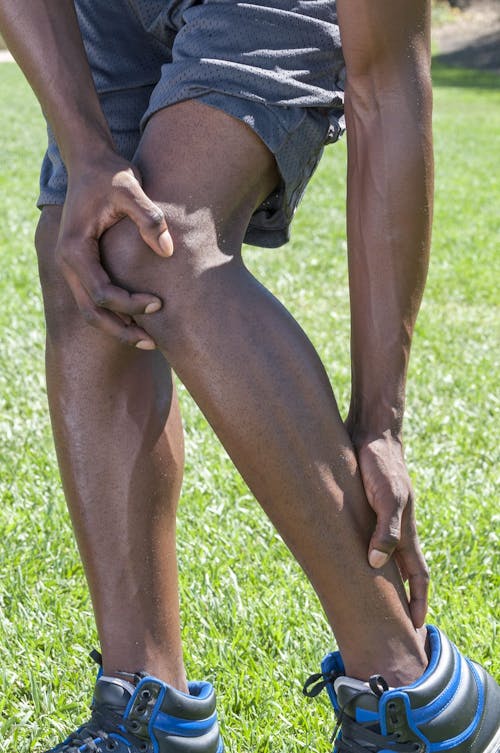-
Sprains and strains are common injuries that we sustain with daily activities, recreation, and competitive sports. But what is a sprain and what is a strain?
Strains
A strain is the tearing of muscle fibers. Muscle fibers are the individual units that make up your muscles. When you call upon the muscle to perform strong or repeated contractions, you may suffer a strain. To further confuse the layperson, strains are classified into grades I, II, and III. Another way to think of these grades is mild (grade I), moderate (grade II), severe (grade III).
- A grade I strain is a mild disruption of the muscle fibers. There may be mild swelling, mild tenderness, and it may be painful to stretch and use the injured muscle.
A grade II muscle strain indicates moderate muscle fiber damage. The pain is moderate to severe, it definitely hurts to use and stretch the injured muscle, and ecchymosis may be present. Ecchymosis (commonly called bruising) indicates that there was internal damage to blood vessels that resulted in bleeding within and around the muscle. This bleeding is often visible under the skin as a purple, blue, red, yellow, and even green in color.
- A grade III strain is the most severe. It is the complete tearing of a muscle into two pieces, or separation of the muscle from its associated tendon. There is severe pain, complete loss of muscle strength, swelling is normally present with ecchymosis, and there may be a palpable “indentation” where the muscle is torn. Medical intervention is usually necessary. Typically, an orthopaedist (musculoskeletal specialist) will evaluate your condition and surgical repair may be necessary.
Sprains
Sprains are tears of the ligaments and capsules (tissues around joints). Ligaments are made up of bundles of somewhat elastic, collagen tissue and attach one bone to another. Capsules typically partially or completely surround a joint. In a synovial joint, there is lubricating and nourishing fluid within the capsule called synovial fluid.
Like strains, sprains are classified as grade I, II, or III in their severity.
- A grade I sprain involves a minimal number of ligament fibers. There may be pain, swelling, and only mild loss of function.
- A grade II sprain is a moderate or partial ligament tear. There is usually moderate to severe pain, swelling and bruising are typically present, and there is a loss of joint function (e.g., it is extremely difficult or you are unable to walk on a grade II ligament sprain of the ankle).
- A grade III sprain is a complete tearing of the ligament or joint capsule into two pieces. Severe pain, swelling, bruising, and loss of function are associated with a grade III sprain. As with grade III strains, orthopaedic intervention/surgical repair may be necessary.
- A grade I strain is a mild disruption of the muscle fibers. There may be mild swelling, mild tenderness, and it may be painful to stretch and use the injured muscle.
-
Tendinitis and Bursitis: Understanding the Conditions and How Physical Therapy Can Help
Tendinitis and bursitis are two common conditions that affect the tendons and bursae in our body. These conditions can cause pain, inflammation, and limited range of motion, making it difficult to perform everyday activities.
We will share more about what tendinitis and bursitis are, how they start, and how physical therapy can help in managing these conditions.
What is Tendinitis?
Tendinitis is the inflammation of a tendon, which is a fibrous cord that attaches muscles to bones. It can occur in any tendon of the body but is most common in the shoulder, elbow, wrist, knee, and ankle.
Repetitive motions, overuse, and poor posture are common causes of tendinitis.
Symptoms include pain, swelling, and limited mobility of the affected joint.
What is Bursitis?
Bursitis is the inflammation of a bursa, which is a small fluid-filled sac that acts as a cushion between bones, tendons, and muscles. It can occur in any bursa of the body but is most common in the shoulder, elbow, hip, and knee.
Like tendinitis, repetitive motions, overuse, and trauma are common causes of bursitis.
Symptoms are similar to the above and may include pain, swelling, and limited mobility of the affected joint.
How Can Physical Therapy Help?
Physical therapy can help with the management of tendinitis and bursitis by reducing pain and inflammation, improving range of motion, and restoring function.
We will assess your condition and develop a personalized treatment plan that may include the following techniques:
- Exercise Therapy – We may prescribe exercises to help strengthen the affected muscle, improve flexibility, and restore range of motion.
- Manual Therapy – This technique involves hands-on manipulation of the affected area to reduce pain, inflammation, and improve mobility.
- Modalities – We may use various modalities such as ice or heat therapy, laser therapy, shock wave therapy, or electrical stimulation to reduce pain and inflammation.
- Education – we will share
Let Us Help You Heal
If you are experiencing pain, swelling, or limited range of motion in any joint, consult with a physical therapist for an evaluation. Early intervention can help prevent further damage and improve your quality of life.


